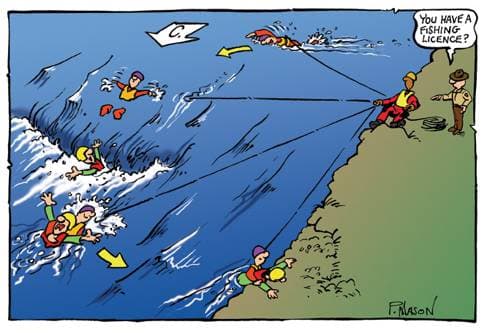Advanced Rescue - Tethered Rescue
The best rescues are the most basic rescues and the ones that keep the rescuer as clear as possible from danger. This is why the throw rope is the primary rescue tool for whitewater paddlers, since the rescuer can effectively help a swimmer from a safe position. Sometimes a rope thrown from shore won't do the trick. A tethered rescue is an advanced rescue technique in which a rescuer swims out to the victim, manually frees them, and then holds onto the victim as they get pulled back into shore. This is the type of 'last resort' rescue to implement when the victim is unconscious or the situation is not appropriate for a rope or boat rescue.
A tethered rescue requires multiple rescuers and a PFD with a quick-release chest harness system. If you own one of these vests, make sure you're very familiar with the quick-release system before you consider using it. The bag end of a line would be securely attached to the back of the rescuer's vest as a tether. One person should use a hip belay to manage the free end of the line, which should have no knots or loops in it at all. Anyone else present could be used to help secure the belayer, communicate with the rescuer, or provide safety down below. If anything happens to the rescuer, the person on shore can pull him or her back to safety. On the other hand, if the situation becomes too threatening, the rescuer can release from the tether at any time. It really depends on the situation.

Swimming out to the victim will be more difficult the further away she is because of the drag created by the tether. Keep this in mind when planning the rescue! The main risks to the rescuer are being injured while entering the water, or getting to the victim and becoming entangled in excess slack in the rope. The rescuer should be a very strong swimmer and the person on belay must be experienced so as not to hinder or endanger the rescuer. Finally, make sure there is nothing that the line may get hung up on and that other river users know it is there. Have a predetermined exit spot and, if possible, other rescuers downstream in case something goes wrong.
The objective is to reach the victim and get him or her to safety as quickly as possible. Turning the victim on their back, the rescuer can hug them from behind and under the arms while both are being pulled to shore. This will provide a secure hold, with the rescuer taking the force of the river and keeping the victim's head above water. It also makes it possible to keep the neck relatively stable if there is any suspicion of a cervical spine injury. If the rescuer must release from the line, the best technique is to swim backwards with one arm while reaching under one of the victim's arms and hugging him or her so their head is resting against the rescuer's PFD. This is very difficult and tiring; remember that the rescuer should always give priority to his or her own safety.
Although the chances are very low that you'll ever need to use this rescue technique, if the situation ever does arise, I can't emphasize enough how important it is to have practiced this type of rescue beforehand. This is why a swift water rescue course is so valuable, and should be considered by all paddlers.
This article is an excerpt from Ken Whiting's recently revised book,
'The Ultimate Guide to Whitewater Kayaking - 2nd Edition'
Ken is a World Champion Kayaker and the author and producer of an award winning series of instructional kayaking books and videos. He was recognized by "Paddler Magazine" as one of their 'Paddlers of the Century'. For more information, visit www.helipress.com.
Ken's book 'Rolling A Kayak' and latest DVD,'Recreational Kayaking: Essential Skills & Safety' are available in the Paddling.net Store! Along with his other popular DVD's like 'Ultimate Guide to Sea Kayaking'
Related Articles
In this video, Chad is kayak fishing in the river in Happy Valley, Pennsylvania. He shares important…
Whether you paddle with a group or you enjoy paddling solo, there may come a time where you would need…
The traditional All In Recovery takes some time and a good deal of orchestration and manipulation to…
We have already presented two other re-entries that can be used by the paddler after they have wet…


